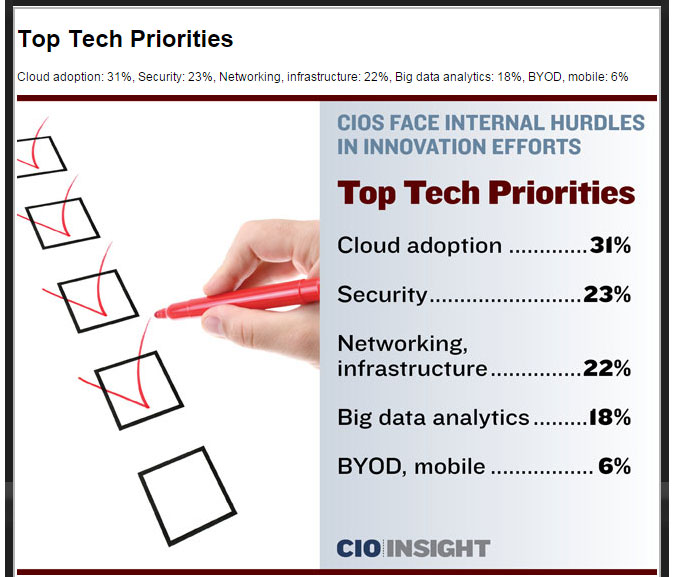What’s New at Kinetic: Building Smart in 2026
At Kinetic, we believe the future of Business Process Management isn’t bigger—it’s smarter.
CIOs have help with innovating in networking, infrastructure, and security on their wish lists this year, though cloud adoption is at the top.

CIOs have help with innovating in networking, infrastructure, and security on their wish lists this year, though cloud adoption is at the top.
That’s according to CIOs Face Internal Hurdles in Innovation Efforts, a research study on top tech priorities published earlier this year by CIO Insight. This post won’t unwrap that entire package, but will peek at a few of the goodies inside.
Information gap: “Nearly two-thirds (of CIOs in this survey) say their organizations are only ‘fair’ or ‘poor’ at documenting, retaining, and putting ‘tribal knowledge’ about technology to use.”
Documentation has always been challenging, though on the developer side, modern collaborative development platforms do help systematize and make the process somewhat more naturally part of the workflow.
But on the user side, the best approach to documentation is to design systems so simply that no documentation is required. Sites like Facebook and YouTube are great examples of this in the consumer world; it’s nearly impossible to reach a human being who can help with use questions on either of those sites, but operations on both are so simple that the need to ask technical questions is rare.
Inside the enterprise, replacing the typical hodgepodge of different systems, emails, and phone calls for requesting services with an intuitive enterprise request management (ERM) portal is one example of a system that requires no training and (generally) no documentation.
And when things go wrong (as they inevitably will–email stops working, an enterprise application is suddenly unavailable, etc.), CIOs can turn to self-documenting problem collaboration tools to coordinate team efforts to identify and resolve issues quickly.
Stalled progress: “More than one-half describe their companies as ‘slow’ at best–if not ‘shaky’ or ‘shameful’–in delivering new IT initiatives.”
Three strategies for addressing speed issues are:
– Use agile development techniques to deliver partial solutions and “quick wins” rapidly, and iterate to gradually build broader capabilities.
– Empower users with tools to address their own needs, such as graphical mapping tools for process automation.
– Leverage in-place investments in legacy management and control systems by building modern systems of engagement to utilize capabilities in new and more user-friendly ways.
Major players: “Six of 10 CIOs and other tech execs say the CIO and IT department are viewed as ‘important’ or ‘critical’ within the organization.”
That’s great for six in 10 CIOs, but–what about the other four?! With the increasing application of information technology across business functions and operations, one would hope that the CIO and IT department would be viewed as “important” in pretty much every enterprise.
As CIOs shift their focus from cost-cutting (where it’s been the past several years) to aligning IT with the business, the view of IT should change. Though business users can in some cases work around IT to address specific data needs, all parties are starting to recognize that the solutions created will be more secure, supportable, and compatible with existing organizational technology infrastructure if IT is involved from the outset.
Healthy appetite: “Nearly 60% say their companies are either ‘hungry’ or ‘starving’ when it comes to embracing new ways to pursue tech solutions.”
One key strategy for solving business problems more quickly is take an “evolution, not revolution” approach whenever possible. Not every problem requires an expensive, time-consuming and disruptive “rip and replace” software project.
While there are certainly times when a significant software suite or platform has simply outlived its usefulness and needs wholesale replacement, in many cases existing investments can be leveraged to address new problems through systems of engagement (as noted above) and workflow automation/integration tools.
And even when entirely new suites or platforms are necessary, solving current business problems needn’t be put on hold; integration tools that utilize open communication protocols (API’s, Web Services, SOAP, REST, etc.) are designed to work with the systems enterprises have in place today as well as whatever they will have in place tomorrow. That means solutions built using these tools today needn’t be thrown out when new enterprise software is installed, but rather can be moved forward with only minor updates.
Here’s hoping CIOs find what they’re hoping for under their trees this year. And that your holiday wishes are fulfilled as well.
Next Steps

At Kinetic, we believe the future of Business Process Management isn’t bigger—it’s smarter.

IT support automation uses software workflows, rule engines, AI/ML, and integrations to automate...

Business process reimagined is the strategic renewal of how work gets done by combining modern digital...